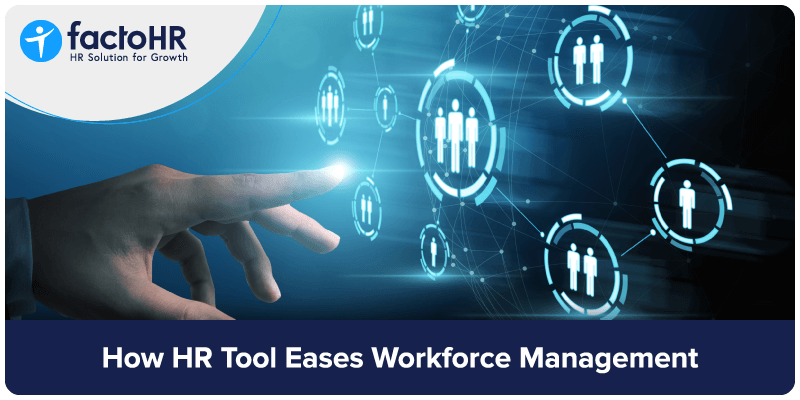How HR Tool Eases Workforce Management

Table of Contents
Workforce management is an employee management method that helps businesses thoroughly understand their operation and relevant business metrics. It refers to a specific organizational strategy and an associative set of processes to maximize employee productivity and satisfaction, thereby increasing overall efficiency. Utilizing the best HR software in India can significantly enhance workforce management practices. These solutions offer features like skills gap analysis, resource allocation tools, and time-tracking functionalities. Organizations can use automated HRMS solutions to allocate the correct resources with the right skills in suitable projects at optimal costs.
What Comes Under Workforce Management
Workforce management includes several processes that help to build and maintain a productive workforce.
- Recruiting process
- Real time data collection
- Human resources management
- Training management
- Performance Management
- Budgeting
- Forecasting
- Scheduling
- Analytics
The successful implementation of a workforce management system ensures that companies continue to work bearing in mind the business vision of the organisation.

Importance of Workforce Management
Implementation of a well-worked out system has several advantages for an organisation as well as its employees.
- Increased employee engagement and satisfaction
- Increased productivity and reduced costs
- Effective scheduling and time off management
- Consolidated reporting
- Better customer experience
As a business grows, scaling, workflow optimization and process automation, all become complex. Managing the human resources of the organisation also becomes a more arduous process since the number of employees increases. At such times, it is all the more necessary to maintain the essential processes such as human capital management in a functional state and accessible whenever needed. This is hard to achieve with manual processes. In order to cover all activities related to workforce management in a more organised and efficient manner, automation is the most preferred approach.
Need for Workforce Management Software
This software is frequently integrated with third-party HR applications and the core HR module, which acts as a central repository for all data. A good platform enhances the performance of the organisation, simplifies daily functions and provides valuable insights about the working of the organisation. Above all it frees up a lot of time for the HR personnel so that they may direct their efforts in achieving better work relations with the workforce.

Must Have Modules
The various modules which can be covered in the system are:
- Employee Information
- Attendance and Leave Management
- Payroll
- Recruitment and Training
- Forecasting and Scheduling
- Performance Management
- Analytics and Reporting
8 ways in HR Tool eases Workforce Management
Due to increased use of cloud computing and rapid expansion of workforce analytics, this software has seen wider acceptance and significant growth. Listed below are a few benefits that an organisation can experience with its implementation:

Better Performance Management
Performance problems at the workplace can lead to extreme dissatisfaction among employees and decreased productivity. An automated system can be configured to facilitate regular reviews. With the use of a 360-degree feedback system, the system becomes robust, efficient and result oriented. This gives managers and supervisors multiple perspectives. Goals can be set throughout the year and/or modified based on work in progress. This encourages employees to track their pace of delivery and reach goals within the set deadline. Periodic feedback can help with instant implementation of suggestions resulting in higher productivity. Using the Human Resource Management System (HRMS) it is no longer tedious collating annual performance data of employees.
Improves Effectiveness of the Organisation
The workforce management tool is completely self reliant and therefore helps in maintaining consistency in managing various HR activities. It promotes transparency and improves employee engagement. The system helps to highlight business goals and improves commitment, and information exchange amongst the workforce. Automating the system eliminates much of the unnecessary and overlapping work. By saving employees’ time, it enables them to spend more time on value creation activities. . Automation helps to bring about policies and procedures that are streamlined and easy to navigate.
Effective Scheduling and Time Off Management
Scheduling employee shifts correctly is the key to make or break an organisation, especially if there is more than one shift. When the process is automated, it allows for staff planning to be based on variables such as vacations, availability, workload and/or absences. It also saves a lot of time otherwise spent in seeking approvals and taking into consideration availability of employees. This ensures that there is no overlapping or shortage of staff at any point in time.
Caters to Learning Needs of Employees
The learning needs of employees should be identified based on the skills of employees and the roles they play. It is necessary for employees to gain new skills to stay relevant in their field of work. By integrating a learning system into the HRMS, it is possible for employees to opt for training that is relevant to their work and necessary to advance their career. Automating the process helps employees to take up the various training programs when on the go and not necessarily in/during office hours.

Cost Efficient
Investing in workforce management automation is a worthy investment. The amount of money spent on wages to complete mundane administrative tasks can be avoided. Secondly the expenses incurred needed to rectify errors arising from inconsistencies and non compliance can be avoided since the system is automated.
Metrics
The software captures insightful data and metrics that can be used to analyse various aspects of the HR function. It was found in a study conducted by Oracle, that HR is overtaking finance as an analytics-driven function. HR teams are widely using metrics data to determine future workforce plans, predict turnover in critical roles and so on. Since all the data is in real-time, it becomes easy to link it with the business goals of the organisation and ascertain the route ahead.
Employee Benefits Administration
These benefits consist of non wage compensation provided to employees besides their salary. It may include housing allowance, insurance, retirement benefits, sick/paid leave and so on. Having an automated system in place helps to administer the benefits correctly. With the help of such HR tools the rights and benefits due to employees can be safeguarded by accurately managing their overtime, bonus, arrears, workplace safety and insurance reimbursement. When the whole system is automated, calculation and allocation of resources is made transparent to employees.
Self Service Portal
Effective employee management systems allow employees to access their HR records at any point of time. Empowering employees with access to their records is perhaps one of the most important features of the system. All the company policies, rules and regulations can be fed into the system which can be accessed by employees as and when needed. This way employees do not have to wait for HR personnel to answer their query. This smooth flow of information boosts efficiency and transparency in the organisation.
With suitable software to assist the HR department, the organisation can overcome the many challenges faced by handling all its functions manually. Automating workforce management has the advantage of incorporating a large database of information, automating numerous workflows, creating reports for analysis as well as remaining compliant.
Grow your business with factoHR today
Focus on the significant decision-making tasks, transfer all your common repetitive HR tasks to factoHR and see the things falling into their place.

© 2025 Copyright factoHR


